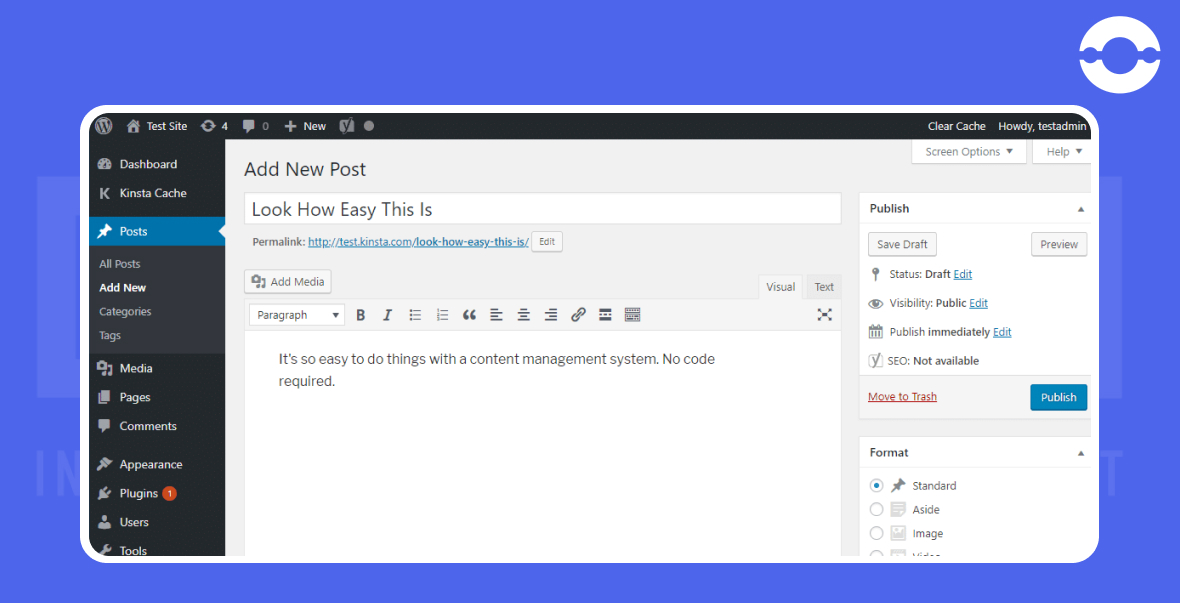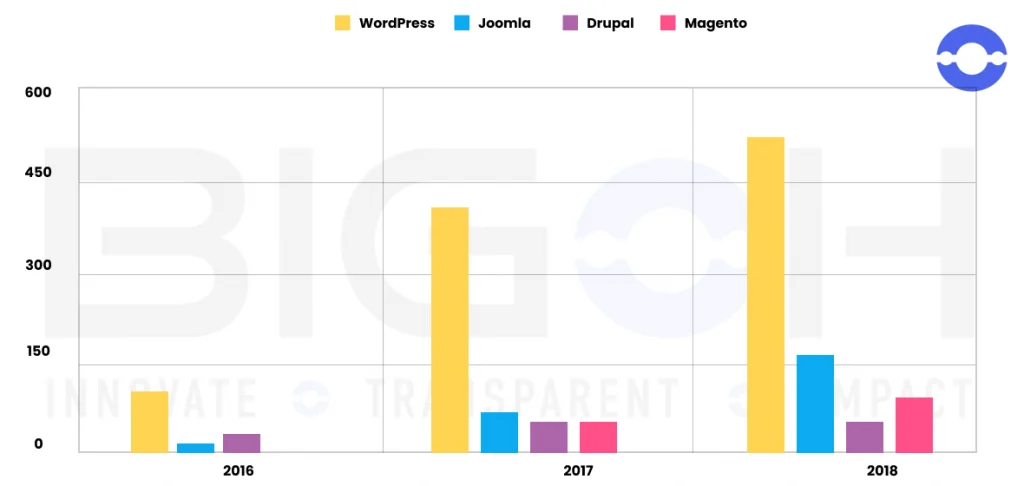There are a lot of acronyms used in the business domain. CMS is one of the most popular amongst them with around 85 million website built using one till January 2023. Among the CMS platforms, there are Headless CMS and then the traditional ones. In this blog we would look at the differences between KeystoneJs, that belongs to the former category and WordPress, the latter category CMS. Therefore, we would look at KeystoneJS vs WordPress.
So, let’s begin with the most basic and important question:
Content Management System (CMS) is a tool that enables a user to build a website without writing codes from scratch or sans the need for specialized technical knowledge. Multiple users can create, manage and publish content at the same time on a website using CMS.
CMS enables companies to manage and store digital content in a single place with collaboration access provided upon permission to the concerned teams. All this is done using minimal technical assistance.
Moreover, the CMS interface is a browser- face allows companies to access it from anywhere. It is an easy and cost-effective solution that saves the business the cost of hiring a full-time content development team as well as reduces their reliance on front-end developers to make changes to the website.
There are some popular CMS platforms like Joomla, Drupal, Wix, Progress Sitefinity, Square Space, etc. However, the most popular one among them is WordPress.

In a survey taken by BuiltWith, 49% or nearly half of the top 1 million websites using CMS used WordPress as their preferred platform.

Created as a standalone project way back in 2003, WordPress has come a long way. The brainchild of Matt Mullenweg and Mike Little, WordPress is now an open-source software that is growing in popularity and scope through the efforts of a huge community of contributors.
WordPress is used to develop business websites, eCommerce stores, blogs, portfolios, resumes, forums, social networking sites, membership sites, etc.
Microsoft makes use of WordPress to power its official blogs, Rolling Stone’s website is powered using WordPress, and even The White House government uses WordPress for its website.
However, every coin has two sides. Therefore, while WordPress is one of the most famous CMS platforms, it is not necessarily the best option available out there, all the time. It has its own set of drawbacks.
Here are some of the disadvantages of WordPress
Due to being an open-source platform, WordPress is vulnerable in multiple cases and a prime target for potential hackers. In fact, WordPress accounted for 90% of hacked websites in 2018, up from 83% in 2017.

WordPress heavily relies on plugins and themes for customisation which remained as one of the biggest threats to websites built using it. In fact, 150% growth in vulnerabilities were reported in 2021 compared to 2020, which was seen as a significant increase.
In WordPress, the more plugins one uses, the more he/she would face compatibility issues. In order have a functional website, one has to make frequent adjustments to plugins and themes, and WordPress is a high-maintenance application.
If in case you lack the budget or the basic design and programming knowledge, it becomes difficult to navigate through the application as support and solutions could found only on WordPress forums. This increases the chances of a user choosing or switching to some other platform.
Customization in WordPress needs a lot of coding. Whereas, category and tagging features of it create a lot of problems for users lacking SEO knowledge. Over-tagged or content marked into many categories is flagged by Google as duplicate content and this leads to low rankings in SEO.
Another major drawback of the traditional CMS platforms like WordPress is that their approach to managing content brings everything into one basket — content, images, HTML, CSS, so on and so forth. This disables the reusability of content because it was commingled with code.

Traditional CMS like WordPress also failed to keep up with the rapid innovations and diversification of devices as it only manages 1:1 content deployment to one, static web page, coupling the front end with the back end, locking the content, and restricting it to fit any other digital platforms or software.
This problem of traditional CMS was solved by headless CMS platforms.
Headless CMS software is a type of back-end CMS that functions independently of the front-end display layer. Through Application programming interface (API) technology content is integrated into any system, software, or website as it enables the front end and back end to work together.

In fact, by 2027, the market for headless content management system (CMS) solutions is projected to expand to $1.6 billion, up from $322 million in 2020. That’s a nearly 400% increase.
This software facilitates an omnichannel experience, is easy to use and learn, highly scalable, more secure than the traditional CMS, and offers more flexibility of usage.
WordPress also tried to come up with a solution in order to enable multichannel publishing with a Headless WordPress in the name of WordPress REST API. This software attempted to widen the range of applications that WordPress can be used for. However, it did not prove to be a very successful endeavour and has many drawbacks.
Some other famous headless CMS platforms are Contentstack, DotCMS, Cockpit, Kontent.ai, KeystoneJS, Ghost CMS, etc.

Keystone is one of the most famous headless CMS on the market today. It is a generic content management framework, enabling the development of a variety of web applications using JavaScript.
KeystoneJS should be used to develop large-scale applications such as portals, forums, content management systems (CMS), e-commerce projects, etc.
Being a powerful Node.js CMS and web application framework built on Express and Mongoose, KeystoneJS is a highly productive and collaborative platform that facilitates next-gen workflows and digital transformation for businesses. After describing a schema of content, KeystoneJS auto-generates easy to use GraphQL API and management/ Admin UI, making it easy to build elegant and engaging websites and apps.

KeystoneJS supports the database types such as PostgreSQL, MongoDB, MySQL and SQLite. Furthermore, this headless CMS is highly customizable. It provides highly flexible and intuitive editing environment that takes instructions from your schema. Reusable components can be curated in Keystone for different sections of one’s website.
KeystoneJS feels lightweight, runs fast and the code to configure it is very straightforward and easy to understand. Further, KeystoneJS is an open-source and could deploy to managed services such as Digital Ocean, Heroku, and Render, or your own custom infrastructure.
You can also read- Top 10 Web Development Tools Every Developer Should Know

LUGGit, Brainhub, Carplat, Warren, Cermati, etc., are some of the companies which use KeystoneJS in their tech stack.
Let’s look at the differences between KeystoneJS and WordPress.
Below is the tabular representation of KeystoneJS vs WordPress :
**Features** | **KeystoneJS** | **WordPress** |
Admin UI | Need to be built over the database itself | Auto Generated |
Customization | Easy | If installed on own server |
Extending Features | Easy | Good |
Templates | More options than WP | Less options than KeystoneJS |
Popularity | Less than WP | Widely used |
Open Source | No | Yes |
Installation | Easier installation and use | Yes |
Session Management | Easier | |
Complexity | Lightweight | Complex and bloat |
User Management | Easier but role management is achieved by editing code | 5 basic roles |
API | GraphQL | Restful API |
Database | Postgres, MongoDB | Mysql, MyriaDB |
Documentation | Improper | Good |
Migration | Manual | Automatic |
User Friendly | For developers | Easy even for non-developers |
While WordPress can used by not so technical users, KeystoneJS offers the more control needed by developers to build new websites. But in fact, it is considerably easier to work with KeystoneJS than manually build your website from scratch on WordPress.
KeystoneJS connects you to your MongoDB database using Mongoose, which is the leading ODM package. Furthermore, its Admin UI saves time and makes data management easier.
Keystone is gaining popularity for easy customization, headless cms, APIS in Graphql Although, in a survey taken by the Slant community WordPress was ranked as the 2nd best CMS, while KeystoneJS stood in the 6th position., KeystoneJS creates a content culture that caters to different needs and is relatively easier to navigate through. It is undoubtedly the future of CMS.
The KeystoneJS vs WordPress fight thus is, more often than not, won by the former.
Q1.Is headless CMS better?
Many developers are gravitating towards the Headless CMS as it offers the flexibility to create content for multichannel and connect with a wider audience.
Q2.What is a headless alternative to WordPress?
There are many headless CMS like Magnolia, Contentstack, DotCMS, Bloomreach, Netlify, KeystoneJS, etc.
Q3.Is headless CMS SEO-friendly?
A Headless CMS can offer APIS that can be used by your front end to build a stronger SEO readiness depending upon performance, content, and optimization for various devices.
Q4.Is headless CMS the future of content management?
Yes, with businesses making use of multiple devices and channels to target audience, headless CMS is in fact the future of content management. Thus, in the KeystoneJS vs WordPress debate, the former often takes the lead.